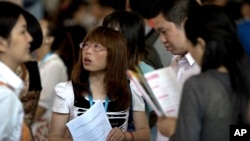The International Labor Organization predicts global unemployment will worsen over the next two years, with emerging and developing economies bearing the brunt of the problem.
The ILO, which released its annual “World Employment and Social Outlook" report Tuesday, said that more than 197 million people around the world were unemployed at the end of last year — 27 million more than the pre-crisis level of 2007.
The ILO forecast 2.3 million more people would be out of work by the end of this year, with an additional 1.1 million jobless in 2017, to reach 200.5 million unemployed.
ILO Director-General Guy Ryder said the slow growth of the global economy was not generating enough jobs to reverse a continuing increase in unemployment.
“These figures reflect a deterioration of the employment situation, particularly in the emerging world and in the developing world, and a marginal improvement, I would say, in the industrialized countries," he said. "But that improvement is insufficient, of course, to compensate for the slowdown and the job losses being felt in the emerging economies in particular.”
Ryder said the situation would continue to underlie increasing unemployment in the years ahead. He cited Brazil, China and the oil-producing countries as being particularly hard hit by the weakened job market.
The report said job quality remained a major challenge. While poverty rates have dropped, the ILO said the rate of decline in the number of working poor in developing economies had slowed. It said about 1.5 billion people were working in vulnerable jobs.
This number included people who were self-employed or worked in the informal sector. The work is typically characterized by low productivity, low pay and no social protection. Countries in southern Asia and sub-Saharan Africa have the highest levels of vulnerable employment, peaking at 74 and 70 percent respectively, the report said.
Authors of the report said governments must strengthen employment policies, enact social protection systems and tackle excessive inequalities. They said more attention must be paid to helping people who find it particularly difficult to enter the labor market or to find decent work. These include young people, women, the long-term unemployed and the disabled.









